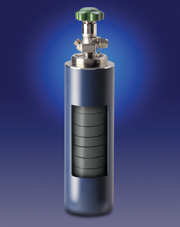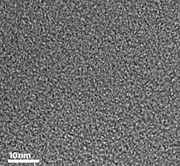Pressured gas cylinders traditionally used by the semicon sector have gradually been replaced by an alternative. Jim Mayer and Lou Blanchard, ATMI, describe how the new systems cut accidental release and deliver higher gas utilisation.
Hazardous, toxic gases are frequently used in a number of semiconductor fabrication process steps in the microelectronics industry. Practical applications require that these gases be stored in, and delivered from, high-density media. Typically, this is accomplished by compressing or liquefying the material in conventional high pressure gas cylinders. While high pressure cylinders are still widely in use today for many gases, it is no longer the preferred method for storing and delivering the most toxic gases, where an accidental gas release or a compromised cylinder could lead to immediate death for workers in the vicinity.
The alternative, and now standard method, uses a different medium that adsorbs (or bonds) gas molecules inside nano-sized pore structures, effectively reducing cylinder pressure and virtually eliminating accidental gas releases.
This technology was first introduced by Advanced Technology Materials, Inc (ATMI) under the brand name Safe Delivery Source, or SDS, in the early 1990s as a much safer way to store and deliver dangerous gases. Today, ATMI’s advanced cylinder-based systems known as SDS2 and SDS3 are often the methods of choice to deliver toxic hydrides (arsine and phosphine) or corrosive gases (such as boron trifluoride) used in the ion implantation process steps of making semiconductors.
The adsorbent material used in SDS systems is ATMI’s BrightBlack precision nanoporous carbon. Because gas molecules for different gases are different sizes, BrightBlack carbon has been specifically optimised for pore size and density to achieve the most favourable physical adsorption (or physisorption) of these dangerous gas molecules. In adsorbent-based technologies, material surface area is directly proportionate to how much of a given gas can be adsorbed. BrightBlack carbon in the SDS3 system combines nano pores and density that equate to more than 500 football fields of surface area inside a standard two-foot-tall cylinder.
Gas adsorption
Inside traditional high pressure gas cylinders (e.g. for oxygen, propane, helium), gas molecules are free to move and collide against the inner walls of the vessel, pressurising the system. With these pressurised cylinders, a simple turn or push to the top of the cylinder can open the cylinder valve. Once open, the pressure conditions inside the cylinder force the gas through the valve and out of the cylinder. This, of course, is not optimal for handling lethal gases, but years ago it was common.
Thankfully, the observation of a naturally occurring molecular interaction, made more than 200 years ago, paved the way for markedly improved safety. In the late 1700s, scientists observed that when a gas or vapour is introduced to a solid, it can often be ‘taken up’ inside the solid (uptake of gas by charcoal was studied in 1773 by C.W. Scheele). Certain solids can form a weak bond with gas and effectively adsorb it. Using this knowledge, ATMI developed its SDS technology to provide a safer, more efficient gas storage and delivery system.

By filling the interior space with nanoporous BrightBlack carbon pucks that adsorb gas molecules ATMI creates a sub-atmospheric gas environment in the SDS cylinders. This technology and approach virtually eliminates accidental release of dangerous gases
In the SDS system, molecular gases are weakly bonded (adsorbed) inside the surfaces of nanoporous BrightBlack carbon material. These adsorption forces hinder the mobility (kinetic energy) of the gas species reducing the pressure inside the cylinder to below atmospheric pressure. Process conditions inside the ion implant process reactor that will use the gas provide adequate negative pressure to pull the gas molecules from the BrightBlack carbon into the process chamber, typically at a pressure of 5 x 10E-4. This type of cylinder technology and gas delivery system has greatly reduced the number of accidental gas releases in the semiconductor industry – undoubtedly saving lives in the process.
Another safety note worth mentioning is that independent fire survivability testing demonstrated that during exposure to low- to intermediate-temperature fires SDS cylinders remained intact significantly longer than high-pressure cylinders. In addition, the pressure wave generated during cylinder failure under this test was significantly less with an SDS cylinder, providing potentially more time and safer circumstances for emergency responders in the event of a catastrophe.
Specific nano-structure
The BrightBlack carbon material inside SDS systems is designed for maximum performance and efficiency at a nano scale. To achieve this, ATMI spent many years in continuous development of this material and to date has produced approximately 50 metric tons for commercial use. It starts with a proprietary polymer precursor material. The powdered polymer is first pressure-moulded into rounded ‘pucks’ to the exact dimensions necessary to fit inside the cylinders. When finished and inserted, they will occupy 99% of the internal cylinder space. The pre-formed pucks are then pyrolised inside custom-designed furnaces to produce high-density, non-graphitising carbon. During this thermal process, the molecular conformity of the polymer is slowly transformed into the desired nanoporous size and structure (e.g. 0.6nm).
Precise temperature controls and tight thermal uniformities are necessary to maintain the structural integrity of the carbon at every step of the multi-stage reaction. When the process is complete, BrightBlack carbon pucks with high purity and 95% pore uniformity are optimally produced to adsorb a specific gas.
ATMI’s BrightBlack carbon material may find other applications as well. It is currently being evaluated in large-scale testing for a CO2 capture system.

Magnified surface structure of ATMI BrightBlack precision carbon adsorbent in the round puck form.
Micrograph courtesy of Dr Georgina Laredo at IMP
Semiconductor manufacturers face continual pressure to reduce operating, energy and capital costs. Their use of SDS systems with nanoporous technology has provided many benefits in this regard. In fact, ion implant process tools are typically the largest consumers of energy and cleanroom air in the wafer fabrication facility. Air is drawn through the implanter to dissipate heat from process tools and to provide a dilution safety factor in the event of an on-board toxic gas leak.
Because SDS systems have no moving parts that could fail and, due to the inherent nature of the technology, accidental releases are virtually eliminated. Manufacturers are finding they can greatly reduce costs for air scrubbing and abatement systems by installing SDS systems. By eliminating certain air handling systems, they save energy costs.
And, due to their safety record, SDS systems are also finding favour with manufacturing insurance companies. Furthermore, SDS systems hold more gas than similar-sized high pressure systems and therefore deliver more gas to the implant process, reducing the number of cylinder changes required during operations.
Due to the vast technology difference from the high pressure approach, and because of its inherent safety benefits, many industry regulators have taken note of, and defined, this new class of gas storage and delivery medium. Several regulations and codes have been updated or changed, especially related to how an SDS system – now classified as a sub-atmospheric gas system (SAGS) – should be considered in shipping, storage, and cleanroom usage in place of traditional high pressure systems.
Organisations such as the US Department of Transportation (USDOT) and the US National Fire Prevention Association have created special codes due to this technology. In addition, collaborations such as the ADR, a European agreement concerning the international transport of dangerous goods was developed, as well as a new International Maritime Dangerous Goods (IMDG) code. These developments have led to more advantages for the SDS technology.
The resultant benefits in cylinder shipping alone include reclassification, eased safety restrictions, improved logistics, reduced fuel costs and expedited freight handling – even through the air. In fact, the Department of Transportation previously forbade air travel for cylinders containing highly toxic material but it allowed the first Zone A material (an SDS3 cylinder full of arsine) onto a flight five years ago. No other toxic gas storage technology has been afforded the same opportunity. Moreover, the standard cylinder test cycle established by USDOT at every five years has been doubled for SDS system cylinders to every 10 years.
For almost 20 years, the SDS system has led the way in efficiency and safety advantages in toxic gas storage and delivery. It has also helped change the way manufacturers design their gas operations and manage gas processes. Today, companies can identify many benefits in their business operations thanks to nano-technology in SDS cylinders. As noted, industry regulators have embraced the SDS system and identified new classifications for this type of technology. New codes have helped ease restrictions based on the technology’s advantages and clear lines of distinction have been drawn between SDS systems and high-pressure gas cylinders.




